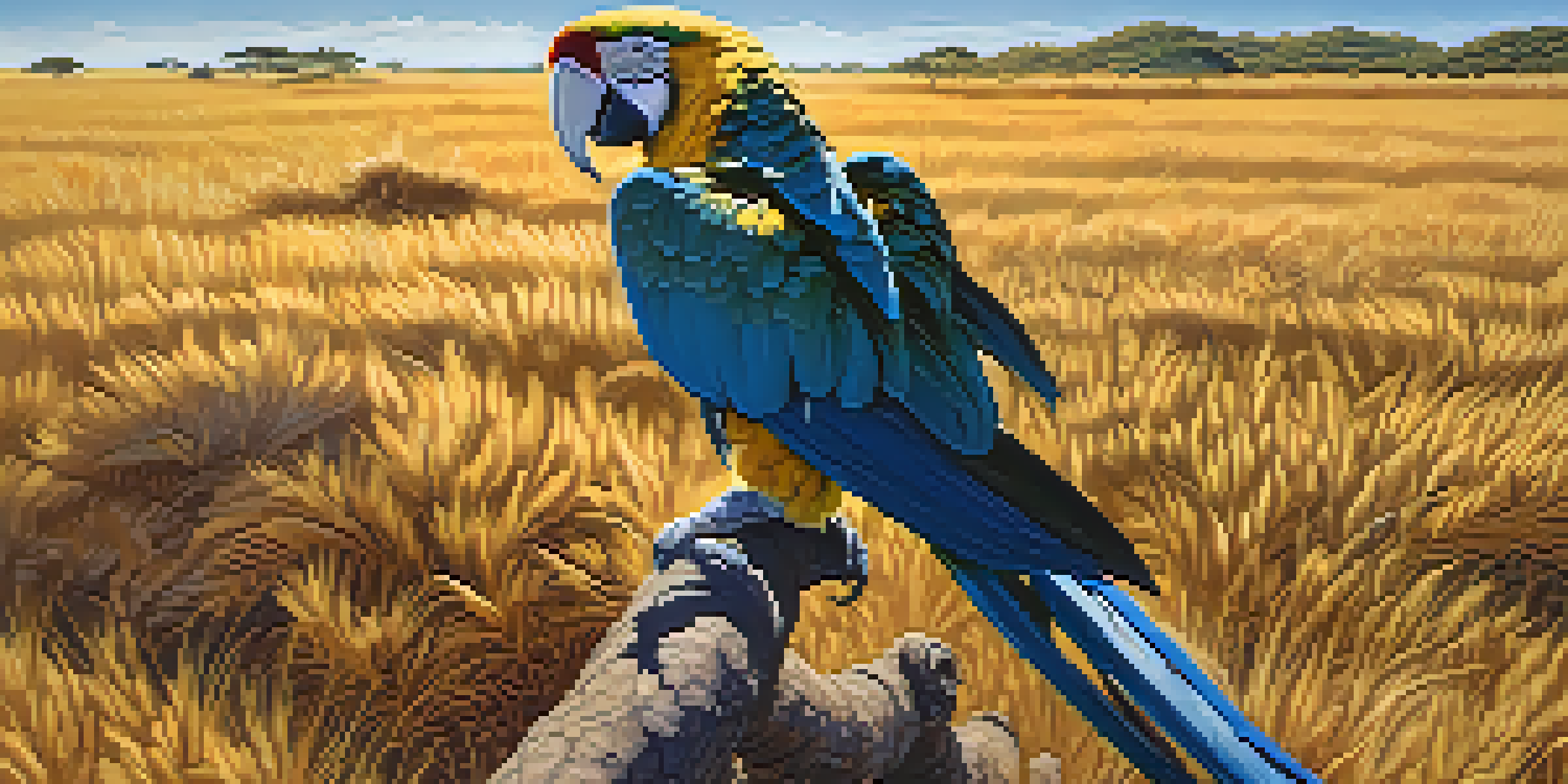Unveiling the Mysteries of the Brazilian Cerrado Ecosystem

Understanding the Brazilian Cerrado: An Overview
The Brazilian Cerrado is a vast tropical savanna that covers about 1.5 million square kilometers. This unique ecosystem is known for its diverse flora and fauna, making it one of the richest savanna regions in the world. It stretches across several states in Brazil, including Goiás, Minas Gerais, and Mato Grosso do Sul, and serves as a vital resource for local communities.
The preservation of the Cerrado is not just about saving a biome; it’s about safeguarding a way of life for countless species, including our own.
What sets the Cerrado apart from other ecosystems is its distinct combination of grasslands, shrublands, and scattered trees. The climate is marked by a pronounced dry season, which influences the types of plants and animals that thrive here. Understanding this environment is crucial for appreciating its role in the global ecosystem and the challenges it faces.
The Cerrado's unique characteristics not only support a variety of species but also play a pivotal role in carbon storage and water regulation. As we delve deeper into the Cerrado, we'll uncover the intricate relationships between its inhabitants and how they contribute to maintaining this rich ecosystem.
Biodiversity: A Treasure Trove of Life
One of the most remarkable aspects of the Cerrado is its incredible biodiversity. Home to over 10,000 plant species, 1,700 animal species, and countless microorganisms, this ecosystem is a veritable treasure trove for scientists and nature lovers alike. The diverse habitats found within the Cerrado support various life forms, from iconic jaguars and capybaras to colorful birds and countless insects.

This rich tapestry of life is not just fascinating; it also serves critical ecological functions. Many of the plants in the Cerrado have adapted to fire, which is a natural part of their growth cycle, helping to maintain the health of the ecosystem. Additionally, the interactions between plants and animals, such as pollination and seed dispersal, are vital for sustaining biodiversity.
Cerrado's Unique Biodiversity
The Brazilian Cerrado is home to over 10,000 plant species and 1,700 animal species, making it one of the richest savanna ecosystems in the world.
However, the Cerrado is under threat from agricultural expansion and deforestation, leading to habitat loss and a decline in species. Protecting this biodiversity is essential not only for the survival of its unique species but also for the ecological services they provide to humans.
The Role of Fire in the Cerrado Ecosystem
Fire plays a crucial role in the Brazilian Cerrado, shaping its landscapes and promoting biodiversity. Unlike in many other ecosystems where fire is seen as a destructive force, in the Cerrado, it is an essential part of the natural cycle. Seasonal fires help to clear dead vegetation, making way for new growth and maintaining the health of various plant species.
In every walk with nature, one receives far more than he seeks.
Many plants in the Cerrado have evolved to withstand and even thrive after fire. For instance, some species have thick bark or fire-resistant seeds that only germinate after exposure to high temperatures. This adaptation not only ensures their survival but also supports the overall ecological balance of the region.
However, human intervention has altered the natural fire regime, leading to more intense and uncontrolled fires. This disruption can endanger both plant and animal life, highlighting the need for sustainable land management practices that respect the natural role of fire in the Cerrado.
Unique Flora: Plants That Define the Cerrado
The flora of the Brazilian Cerrado is as diverse as it is unique. Characterized by a mix of grasses, shrubs, and trees, it features species that have adapted to the challenging conditions of the savanna. Iconic plants like the cerrado tree (Qualea parviflora) and the Brazilian pepper tree are just a couple of examples of the resilience found here.
Many of these plants have developed special adaptations to survive the region’s dry season, such as deep root systems that access underground water. The Cerrado also boasts a variety of endemic species, meaning they are found nowhere else on Earth. This uniqueness further emphasizes the need for conservation efforts in the region.
Human Impact Threatens Ecosystem
Agricultural expansion and deforestation are leading to habitat loss and fragmentation, posing significant threats to the Cerrado's biodiversity.
The plants of the Cerrado are not only vital for the ecosystem but also play a significant role in local cultures. Many indigenous groups rely on these plants for food, medicine, and materials, showcasing the deep connection between people and nature in this extraordinary landscape.
Wildlife Wonders: Animals of the Cerrado
The Brazilian Cerrado is home to a remarkable array of wildlife, from large mammals to vibrant birds and elusive reptiles. Key species such as the maned wolf, giant anteater, and the Brazilian tapir exemplify the unique adaptations that have evolved in response to the environment. These animals often play critical roles in their habitats, such as seed dispersers and prey for other species.
Birdwatchers will be delighted to find over 800 species of birds inhabiting the Cerrado, making it one of the best birding spots in Brazil. The colorful macaws, toucans, and the strikingly beautiful cockatoos not only add vibrancy to the landscape but also help maintain ecological balance through their feeding habits.
However, many of these species are facing threats from habitat fragmentation and hunting. Conservation efforts are essential to ensure the survival of these incredible animals and the preservation of the Cerrado's unique ecological heritage.
Human Impact: Challenges Facing the Cerrado
The Brazilian Cerrado is experiencing significant pressure from human activities, particularly agriculture and urbanization. Large-scale soybean farming and cattle ranching have transformed vast areas of the ecosystem, leading to habitat loss and fragmentation. This rapid development poses a serious threat to the rich biodiversity that calls the Cerrado home.
In addition to agriculture, deforestation and climate change are further exacerbating the challenges faced by the Cerrado ecosystem. As temperatures rise and rainfall patterns shift, the delicate balance that supports the flora and fauna of the region is increasingly at risk. This not only impacts wildlife but also local communities that depend on the ecosystem for their livelihoods.
Conservation Efforts Are Vital
Sustainable land management practices and community involvement are essential to protect the unique ecological heritage of the Brazilian Cerrado.
Awareness and action are crucial in addressing these challenges. Sustainable land management practices and conservation initiatives can help preserve the Cerrado's unique biodiversity while allowing for responsible agricultural development. By striking a balance, we can ensure that future generations can enjoy the wonders of this extraordinary ecosystem.
Conservation Efforts: Protecting the Cerrado
Conservation efforts in the Brazilian Cerrado are essential to safeguard its unique biodiversity and ecological integrity. Various organizations and government initiatives are working to protect the region through the establishment of protected areas and sustainable land use practices. These conservation strategies aim to create a balance between human needs and environmental preservation.
Community involvement plays a crucial role in these efforts. Local communities, particularly indigenous groups, often have invaluable knowledge about the land and its ecosystems. By engaging these communities in conservation initiatives, we can foster a sense of stewardship and ensure that traditional practices align with modern conservation goals.

Education and awareness are powerful tools in promoting conservation. By informing people about the importance of the Cerrado and its biodiversity, we can inspire action and support for preservation efforts. Together, we can work towards a sustainable future that honors the beauty and complexity of the Brazilian Cerrado.